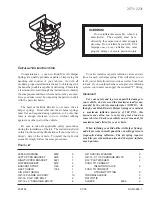
4-5. Use other driving system
156
CAUTIONS
If a vehicle in the adjacent lanes enters the front of the direction in which your vehicle moving but it
is not covered by the monitoring area, the system may not detect it, resulting in sluggish response of
SACC. Pay close attention to the vehicle movement in the adjacent lanes. Control your vehicle actively
if necessary.
If the front car brakes suddenly (emergency stop), there will be a risk that ACC will not respond or
react too slowly, resulting in too late braking.
In this case, you may not receive a request of controlling your vehicle. Exercise extreme caution and
control your vehicle actively if necessary.
If the target vehicle of SACC stops, it means the target vehicle may be screens or there is pedestrian
passing. Exercise extreme caution and control your vehicle actively if necessary.
Caution
ACC will keep the set distance with the vehicle ahead to follow the target. If the target vehicle slows
down and stops, ACC will control the vehicle to stop automatically.
The vehicle will automatically start under the control of ACC if the target vehicle restarts or leaves
the lane within 3s after stopping.
When the target vehicle stops for more than 3s (seconds) but less than 3min (minutes) and starts or
leaves the lane again, the multi-function screen of the vehicle's instrument cluster will prompt the
information of resuming the cruise control. The driver can resume the SACC function by depressing
the accelerator pedal lightly or turning the cruise control handle to "RES+" to realize automatic
starting. At that time, the driver should pay attention to whether it is safe to start the vehicle.
ACC will be automatically released when the vehicle stops for more than 3 minutes.
ACC cannot keep the vehicle in a braking state for a long time. Do not leave your vehicle while the
ACC keeps the vehicle stopped. Be sure to shift the selector lever in the P position before leaving your
vehicle.
Observe the following precautions when cornering with the ACC activated:
●
In a sharp corner, the ACC may be canceled or limit the vehicle speed.
●
On curves, advanced cruise control may react to vehicles in another lane, or may not have time to react to
vehicles in the same lane, may collide with the vehicle ahead, or lose control of the vehicle.
Especially when
driving in a ramp, the vehicle may be accelerated since the system loses its target due to an excessive curve.
Pay special attention to the curve and be prepared to apply the brake if necessary. When driving on a curve,
select the appropriate speed.
When your vehicle follows the preceding vehicle to pass through the intersection with traffic lamps,
observe the change of the traffic lamps and intervene actively if necessary to avoid violating the traffic
rules.
When the vehicle is in a heavy fog, rain, snow and other weather conditions, or frost and smudgy
marks exist in the window area of the camera of the advanced driving assistance system, or when the
vehicle is driving towards the direction of the sun (or strong light source), the camera can report
through the instrument cluster that the camera of the advanced driving assistance system is blocked,
please clean the windshield. ACC cannot work at this time.
Summary of Contents for HS5
Page 2: ......
Page 24: ...22 ...
Page 74: ...2 Instrument Cluster 72 ...
Page 378: ...8 2 Measures to Be Taken in Emergencies 376 ...
Page 379: ...377 9 Specifications Maintenance data 378 Fuel information 390 Vehicle specification 9 ...
Page 395: ...393 List of Abbreviations 394 Other information ...
















































